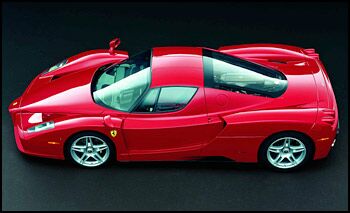
new models: Enzo Ferrari
 |
| The "Enzo Ferrari" is the long awaited
successor to the F40 and F50 line. Ferrari believe that they have built
a pure supercar which pushes the boundary's onwards, and a car worth of
carrying their founder's name. The 6-litre V12 "Enzo" produces 660bhp and
Ferrari claim it is a pure transfer of F1 technology to road use.
349 cars will be built, after a public debut at the Paris Motor Show in the autumn. |
|
| Engine:
The Enzo comes with an all-new 4-valves per cylinder 5998cc 65º V12 unit, Ferrari project code F140. Compression ratio is a suprisingly high 11.2:1 despite the fact that the Enzo runs of usual 95RON pump fuel. With the assistance of variable valve timing the engine can achieve 8,200rpm, in excess of other in-production supercars including the sister 575M, Lamborghini Murcielargo, Pagini Zonda and Edonis. The all-new 225kg V12 pumps out 660 bhp at 7800rpm, higher than the Enzo's V12 competitors. Maximum torque is 485 lbft, not the best in its class, but the Ferrari engineers have aimed at overall power at the expense of torque. Each of the 4 camshafts has continuous variable cam phasing, the first time Ferrari have introduced valve timing to both banks of a production model. Contrary to rumours the F140 engine does not incorporate "ballistic valve-actuation", a system used by Ferrari F1 cars in the early 1990s, which throws the valve stems away from cam lobes at high speed. The, F1 derived variable geometry intake manifold uses a system of small telescopic pumps activated by a hydraulic activator to allow power and peak torque to be maintained. |
| Transmission & electronics:
The Enzo follows the 575M which earlier this year became the first production Ferrari to incorporate an F1-style sequential gearbox. The six-speed geabox is based on a manual version, but fitted with an electronically controlled hydraulic clutch. Like the F1 cars it is controlled by steering wheel mounted paddles and has two modes: Sport and Race. Race mode also stiffens the electronic damping and the traction control can be disenabled on this setting. F1-style launch control is an option: the brake pedal is depressed which the power is fed in, as the brake pedal is released the on-board computer engages the clutch for optimum starting. |
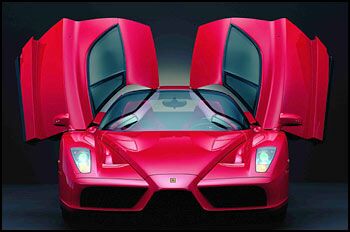 |
| Chassis:
The chassis comprises of an aluminium honeycomb frame, the bodywork being made up of carbon fibre panel, the current route that supercar manufacturers are using. In an effort to push forward the supercar boundary's, Ferrari have attempted to create a low a drag as possible without sacrificing handling. To achieve this end the Ferrari incorporates aero flaps on the front slides and a low rear spoiler. These and the rear diffusers are all electronically adjustable according to the cars speed. At 200 km/h the Enzo achieves 344kg of downforce, rising to 775kg at 300 km/h, well in excess of any rivals. No surprise here. The chassis and body are made of aluminum honeycomb structure sandwiched by carbon fiber panels. This is currently the best materials for supercars. The rear suspensions, engine / gearbox / differential unit are all mounted on aluminum frames bolted to the carbon fiber monocoque. |
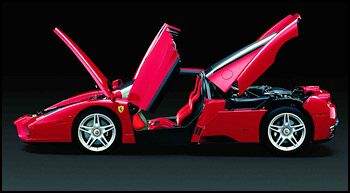 |
| Suspension & Brakes:
The Enzo uses double wishbones all round, dampers and springs connected by a series of push-rods, with electronically adjustable damping. The car runs on a Bridgestone developed tyre, the RE050A with 245/35ZR19 on the front and 345/35ZR19 on the rear. The Enzo features 380mm diameter discs all round, 6-pot front callipers and 4-pot rear callipers. Brembo has developed carbon-ceramic brake discs for the car. Lighter than steel discs, its heat resistant qualities give it much greater stopping power. |
| Performance:
The Enzo Ferrari is a pretty hefty car: longer than the Murcielargo, much larger than the McLaren F1 and Pagini Zonda. Kerb weight is 1345kg, much heavier than had been predicted. Dry weight is still 1255kg, by comparison the F40 was 1100kg and the McLaren F1 1138kg. The Enzo measures out at 4702mm long, 2035mm wide, 1147mm high and a wheelbase of 2650mm. Acceleration time is slower than predicted with 0-60 km/h being achieved in 3.65 seconds. Overall top speed is expected to be slightly in excess of 217mph, both figures some way off the McLaren F1. |
|
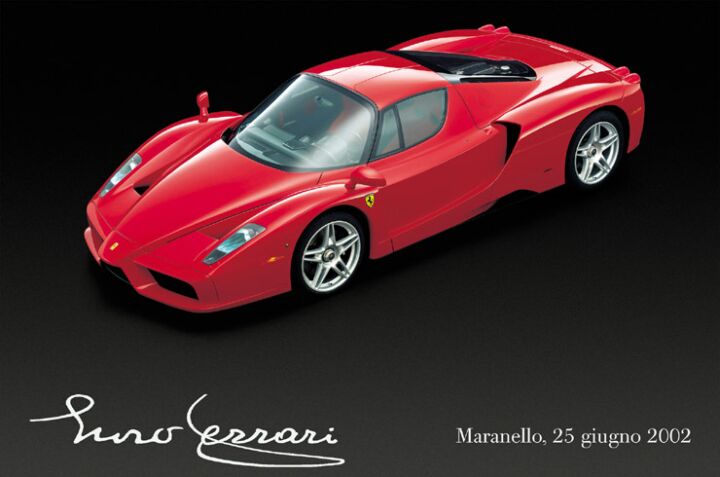 |
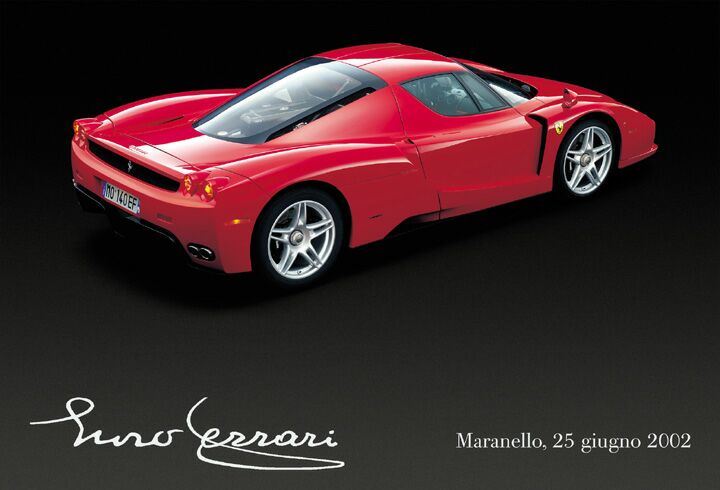 |
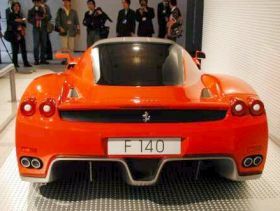 |
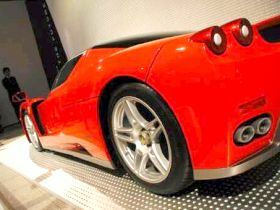 |
The Enzo Ferrari prototype made an unusual debut at a Tokyo museum exhibition dedicated to Ferrari and Maserati earlier this year. |
| <<< |